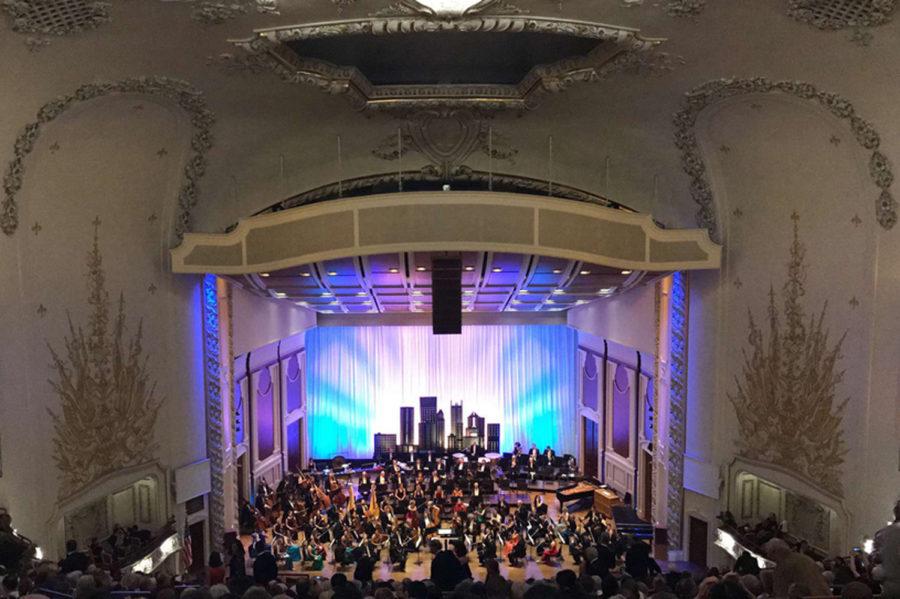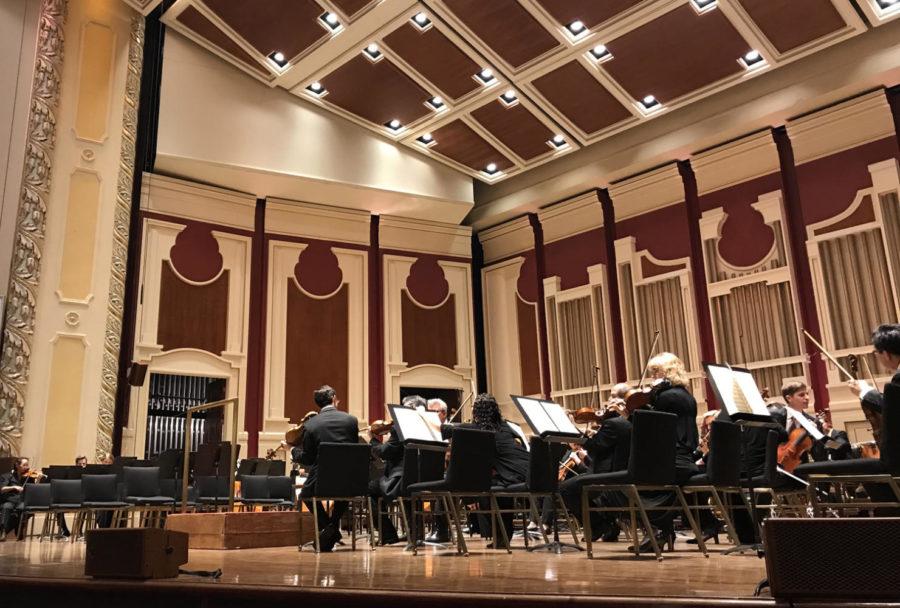World-renowned musicians clad in dark colors quickly filled 101 empty black chairs organized in a crescent shape on the stage.
The Pittsburgh Symphony Orchestra played their program “Shostakovich Triumphant” Sunday at Heinz Hall Downtown as part of their BNY Mellon Grand Classics series.
Polish guest conductor Kryzsztof Urbanski led the orchestra in the concert, which also featured young violin virtuoso Ray Chen. The program included Beethoven’s “Overture to Egmont,” Bruch’s “Violin Concerto No. 1” and Shostakovich’s “Symphony No. 5.”
Urbanski entered the stage exactly on time and began leading the orchestra in Beethoven, noticeably without a score in front of him. Giving a traditional interpretation of the piece, the motives were lyrical and peaceful as they rang throughout the hall.
After the orchestra played Beethoven, guest soloist Chen, wearing a dark blue suit, walked onto the stage with steadiness in his step and an unclenched bow hand to perform his interpretation of the popular Bruch violin concerto.
The final two long notes rang through the hall as Ray Chen swooped his bow arm into the air, a smile plastered on his face. Receiving a standing ovation from the audience, Chen took a bow.
After several curtain calls, Chen entered the stage one last time to play an encore for the audience — Paganini’s “Caprice No. 21” — which he said is his favorite of the Paganini caprices.
The impressive concert hall and talented guest performers made the concert mesmerizing — especially for Pitt junior computer science major Josh Zinkovsky, who attended the concert with his Russian class. He was impressed with the sophisticated ambiance and the skill of the soloist.
“Ray Chen was a true professional — as he was playing the violin, you could hear his passion emanating with every note. Here was a man who dedicated his entire life to his craft,” Zinkovsky said. “It’s pretty inspiring.”
After the orchestral intermission, the musicians returned to the stage to perform the main piece of the night — Dmitri Shostakovich’s “Symphony No. 5.” Before diving into the piece, the conductor narrated Shostakovich’s story to the audience, explaining when the piece was written — in 1937, during the peak of Josef Stalin’s power in Soviet Union. Urbanski had the orchestra play snippets of the piece for the audience, describing the motifs and the images of the music.

For first-year microbiology major Lauren Weigand, Urbanski’s information helped her to better interpret the music.
“I found Shostakovich’s later movements in ‘Symphony No. 5’ to be extremely dramatic and embody the intimidation of living in Stalin’s Soviet state,” Weigand said.
To successfully pull off a concert with such rich musical history, PSO’s artistic department had to prepare for about two years. After decisions about rehearsal schedules, repertoire and concert dates, the department selected and booked the guest artists, at which point the production department — lead by Production Manager Harrison Mullins — began its role.
“When it comes down to it, the crew is the one that runs the show, but it’s my job to figure out what the artistic department wants to do and communicate it to the crew in the best and easiest manner so they understand what is happening and can effectively do their job,” Mullins said.
Mullins creates one of the most important documents, the run sheet — a detailed rundown outlining how the concert will play out. And because the orchestra performs live, Mullins finds that he has to factor in “buffer” times into the run sheet in case of unexpected situations.
“As far as actually running the concert goes, once it starts, it’s pretty simple. The most difficult things are choosing the duration of intermission and choosing if you have to cut a piece or not,” Mullins said.
In order to be the most efficient with the little time the orchestra does have, Mullins creates a “weekly stage tech schedule,” a way for stage crew members to know when and what is occurring onstage during a performance. For this concert it included a scheduled 30-minute warm-up session for musicians as well as a reminder to the stage engineers to shut off the air conditioning several hours prior to a concert to silence even miniscule noises.
“A big part of what [the musicians] do is utilize their ears, they have very acute hearing, so things like that will bother them,” Mullins said. “So during a performance we cut the AC off.”
Minute details like these are what help make the orchestra world-renowned. Pitt professors take classes to the concerts not only to use them as aids for their lesson plans, but also because attending a concert is an honor and a big part of Pittsburgh culture.
Sophomore history major Anthony Marinelli joined his Russian class to see the preparation play out. He found that the trip was not only a rewarding cultural experience, but also an opportunity to interact with other students taking Russian.
“I think adding in these kinds of cultural excursions while learning a language at Pitt makes the whole experience more interesting and dynamic,” Marinelli said. “Given the small number of students taking Russian, I thought it was also a nice opportunity to engage and get to know one another.”



